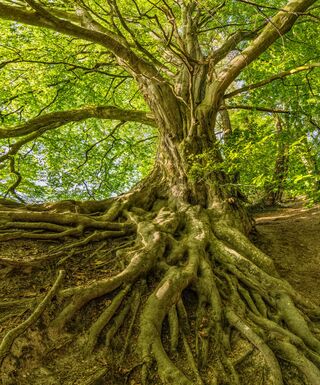Heuristics
The Great Tree at the Centre of the World
A Personal Perspective: A symbol of integration and development.
Posted July 28, 2022 Reviewed by Jessica Schrader
Key points
- Fulfilling our potential requires both grounding and expansion.
- Equilibrium requires constant effort.
- The trees can offer us some advice.

The tree holds a central place in the human imagination, from shamanic narratives to the Garden of Eden to the concept of the family tree. Who among us has not placed our hand on the trunk of a tree, felt the harshness of the bark, gazed up into the lattice of leaves, and then looked down noticing the extent of its root system? Some of the pines in my neighbourhood have reached such dizzying heights that they evoke awe when I (Gillian) walk past them. Even in our secular culture, many plant a tree upon the birth of a child or oversee the growth and progress of maples, ash, birch, or poplar in their yards or in nearby parks. We can measure the periods of our life alongside their growth.
For the Siberian shamans, the Great Tree at the centre of the world connects the underworld, our world, and the heavens. It is from this great tree that the shaman makes a drum that is then used for healing and finding those who are lost. The tree is the great spine connecting all the realms together. The tree has its own secrets and wisdom to offer.
One teaching that the tree can share is that growth and flourishing, and the fruit that will grow in due season, require deep anchoring in the soil. This is a perfect illustration of integrated human development. Often in contemporary culture, especially American culture, there is an implication that full development requires a leap into the unknown and a complete cutting off from the past. Think The Great Gatsby with its made-up name and fictional history. This, however, as we can see in Fitzgerald’s novel, is a dangerous delusion.
Certainly, one way of rooting, and avoiding Gatsby's fate, is by centring in one’s religious, cultural, and family history as we have written about in previous posts. When family histories are problematic (and whose is not to some degree?), there is still the opportunity to identify with positive aspects of traditions and shape them in ways that work in current situations. One of the clearest ways this has manifested during the pandemic is the return to old family recipes, as we all sought to ground ourselves in something solid, familiar, and stable.
Then there is also the opportunity to anchor in nature herself. As Williams writes in The Nature Fix (2017), “ Scientists are quantifying nature’s effects not only on mood and well-being but also on our ability to think—to remember things, to plan, to create, to daydream, and to focus.” (11). I suspect most readers don’t need a footnoted research article to convince them of this. We have the lived experience that a simple brisk walk in a forest or along a lake or the ocean is the quickest way to restore equilibrium, clear one’s head, and induce a state of openness and calm.
Another way to ground is in the body itself and many mindfulness classes teach practices for moving back into the body by focusing on breathing. The yoga asana vrksasana (tree pose) is one that has bedeviled many of us with the requirement that we balance—staying firmly on the foundation of our feet while reaching the arms upward. Not so easy. This pose requires an in-the-moment awareness and constant seeking of balance. So there is no permanence—it is an ongoing process of finding that point that allows for equilibrium.
In her book Between Earth and Sky (2008), biologist and lifelong tree lover Nalini M Nadkarni notes that, like us, trees bear the marks of any trauma that they may have suffered in the growing process as they respond to the impact of gravity and wind (31). Anyone who has visited the Canadian shield will have seen the pines permanently flowing in one direction in response to the gales and the weight of snow that they have weathered. Trees do not emerge from their growth process unmarked or unchanged and neither do we.
So I am inspired by these great teachers, wherever they are found—from the I’ll-grow-anywhere, including-out-of-a-rock-face, jack pine to the delicacy of the white birch, and the maddening and insinuating Norway maple that inspires hatred on the internet. They all have their stories to tell and this is just one of them. They are inexhaustible wonders that at this point in my life’s journey inspire me to keep my feet firmly on the ground while continuing to expand and stretch and attempt to reach out towards possibility.
References
Mircea Eliade and A. Hultkrantz. 1964. Shamanism: Archaic Techniques of Ecstasy. Princeton, NJ: Princeton University Press.
Nalini M Nadkarni. 2008. Between Earth and Sky. Our Intimate Connections to Trees. Berkeley, CA: University of California Press.
Florence Williams. 2017. The Nature Fix. Why Nature Makes Us Happier, Healthier and More Creative. New York, NY: W.W. Norton & Company.


